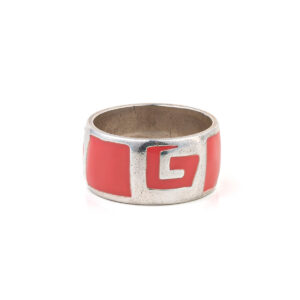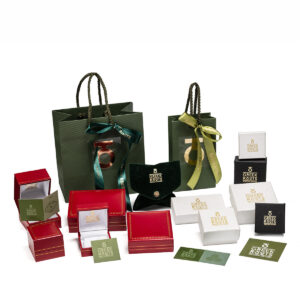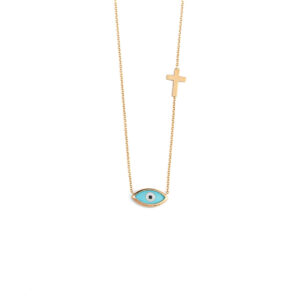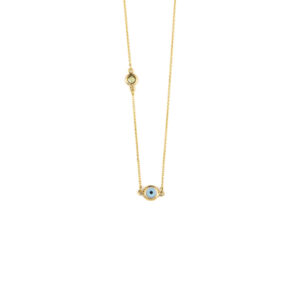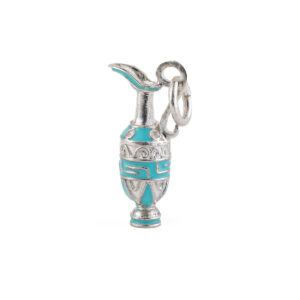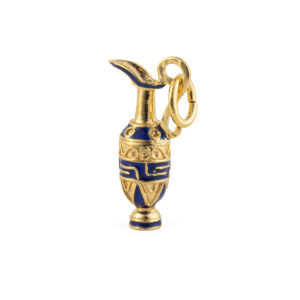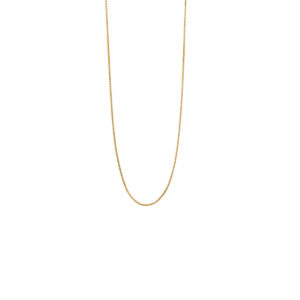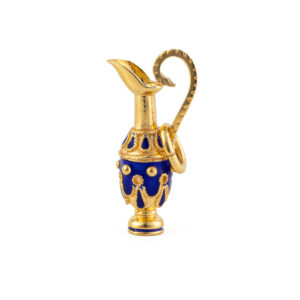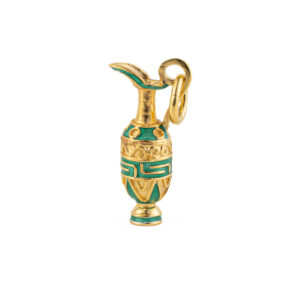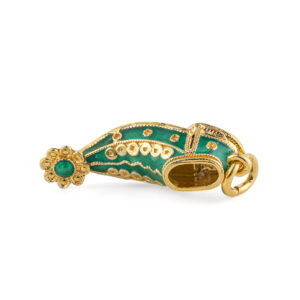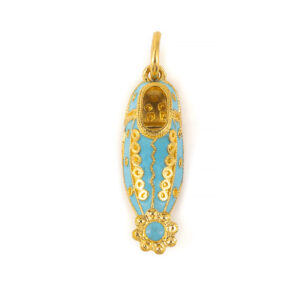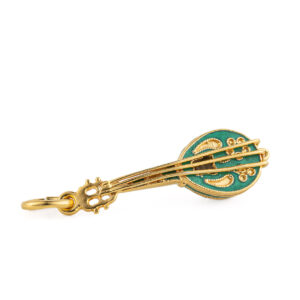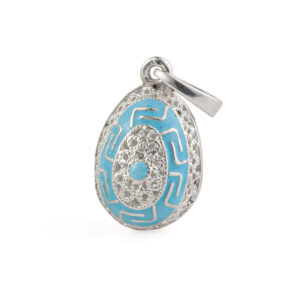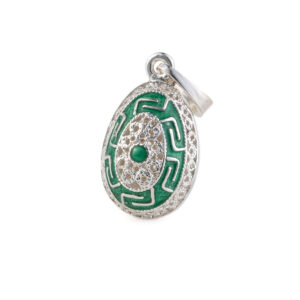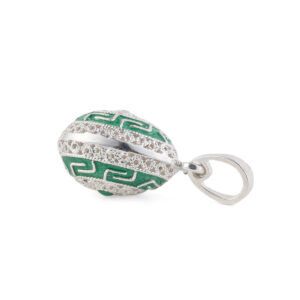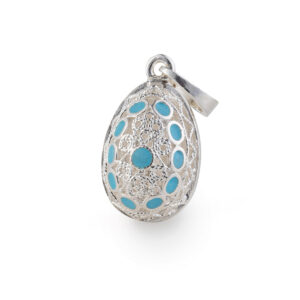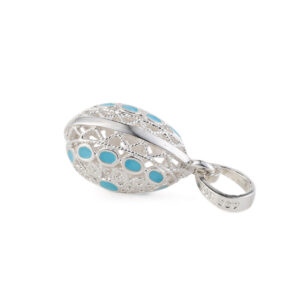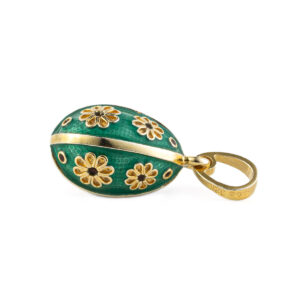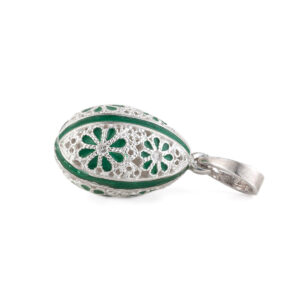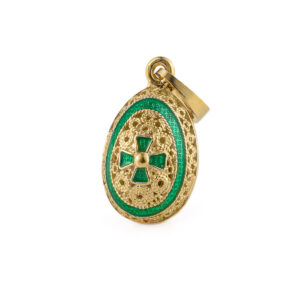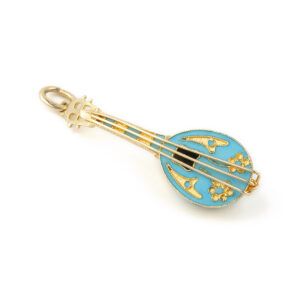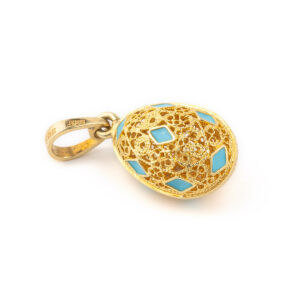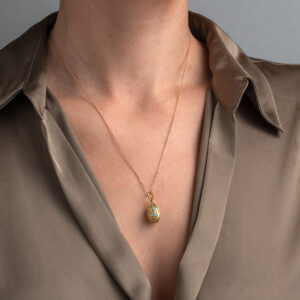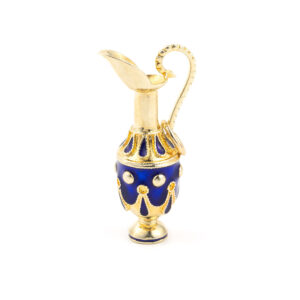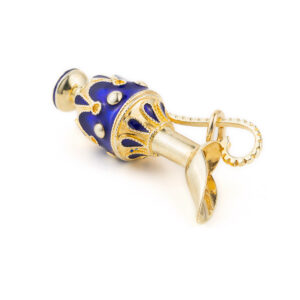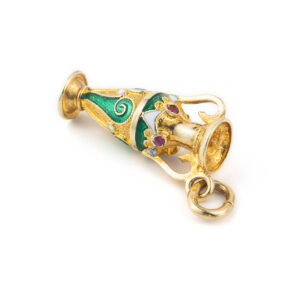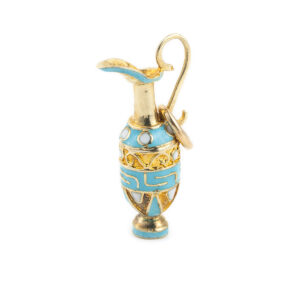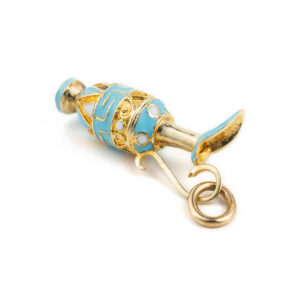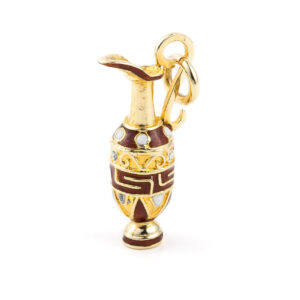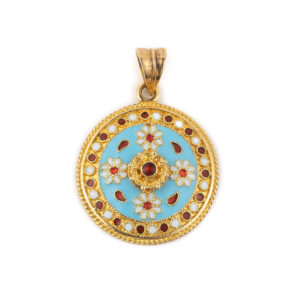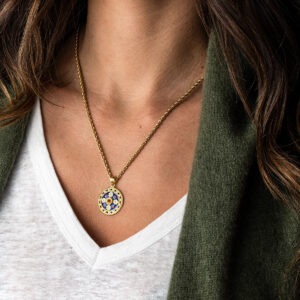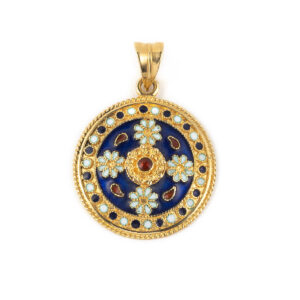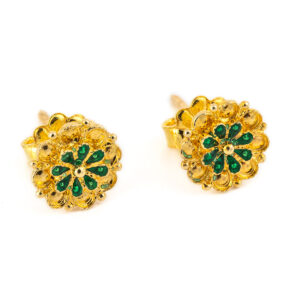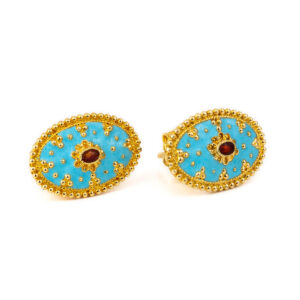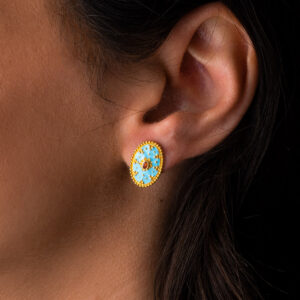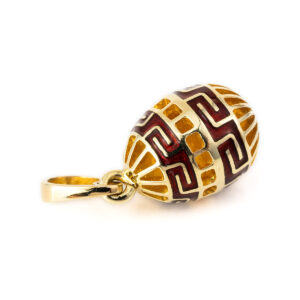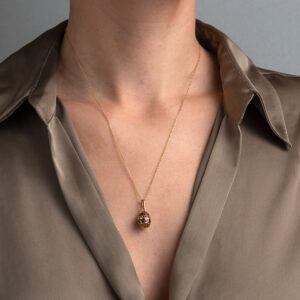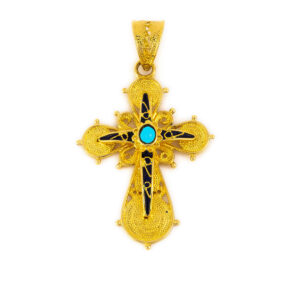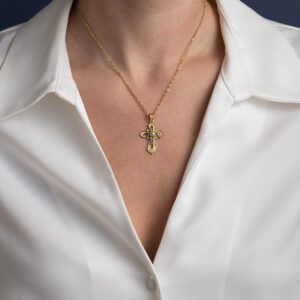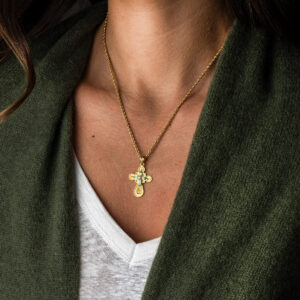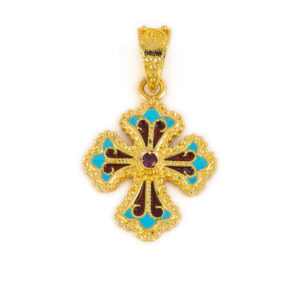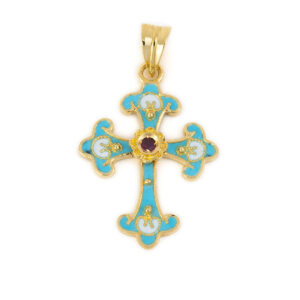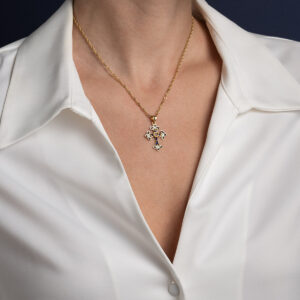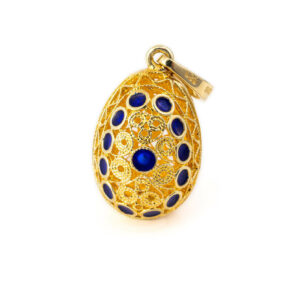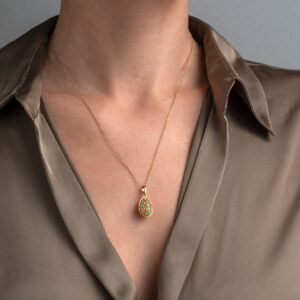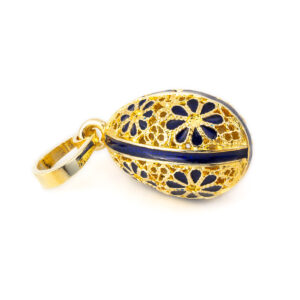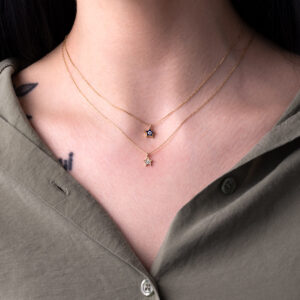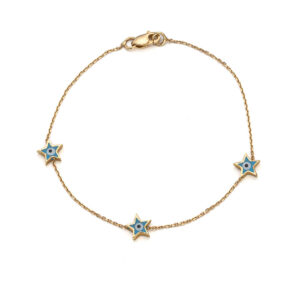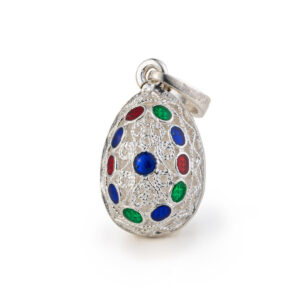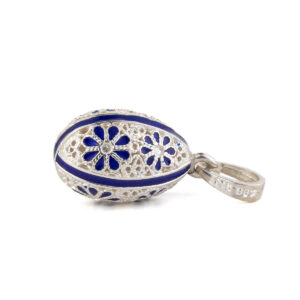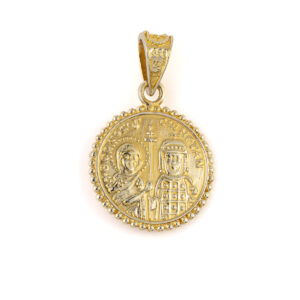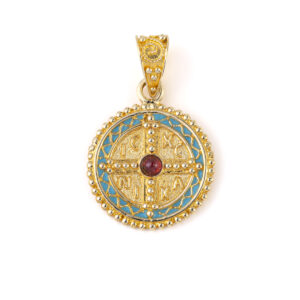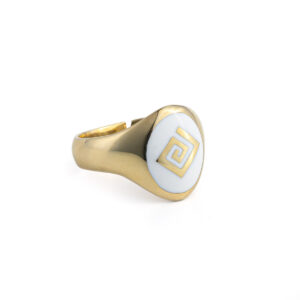Δαχτυλίδι Μαίανδρος Ροζ Σμάλτο – Ασήμι 925
Δαχτυλίδι εμπνευσμένο από το ελληνικό σύμβολο του μαιάνδρου.
Χειροποίητο Ελληνικό Κόσμημα.
Ανακαλύψτε τη Συλλογή Μαίανδρος
Ιστορία
Το σχέδιο Μαιάνδρου είναι ένα διακοσμητικό περίγραμμα που δημιουργείται από μια συνεχή γραμμή, η οποία σχηματίζεται σε ένα επαναλαμβανόμενο μοτίβο. Ένα τέτοιο σχέδιο ονομάζεται επίσης ελληνικός κροσσός ή ελληνικό σχέδιο κλειδιού, αν και πρόκειται για σύγχρονες ονομασίες. Από τη μία πλευρά, η ονομασία “μαίανδρος” θυμίζει τη στροφική πορεία του ποταμού Μαιάνδρου στη Μικρά Ασία, και από την άλλη πλευρά, όπως επεσήμανε ο Karl Kerenyi, “ο μαίανδρος είναι το σχήμα ενός λαβύρινθου σε γραμμική μορφή” το νόημα είναι ότι δεν υπάρχει αρχή και τέλος σε ορισμένες περιπτώσεις έτσι γίνεται το σύμβολο της μακράς ζωής και της αιωνιότητας.
Δαχτυλίδι Μαίανδρος Μπλε Σμάλτο – Ασήμι 925
Δαχτυλίδι εμπνευσμένο από το ελληνικό σύμβολο του μαιάνδρου.
Κατασκευασμένο από ασήμι 925°.
Χειροποίητο Ελληνικό Κόσμημα.
Ανακαλύψτε τη Συλλογή Μαίανδρος
Ιστορία
Το σχέδιο Μαιάνδρου είναι ένα διακοσμητικό περίγραμμα που δημιουργείται από μια συνεχή γραμμή, η οποία σχηματίζεται σε ένα επαναλαμβανόμενο μοτίβο. Ένα τέτοιο σχέδιο ονομάζεται επίσης ελληνικός κροσσός ή ελληνικό σχέδιο κλειδιού, αν και πρόκειται για σύγχρονες ονομασίες. Από τη μία πλευρά, η ονομασία “μαίανδρος” θυμίζει τη στροφική πορεία του ποταμού Μαιάνδρου στη Μικρά Ασία, και από την άλλη πλευρά, όπως επεσήμανε ο Karl Kerenyi, “ο μαίανδρος είναι το σχήμα ενός λαβύρινθου σε γραμμική μορφή” το νόημα είναι ότι δεν υπάρχει αρχή και τέλος σε ορισμένες περιπτώσεις έτσι γίνεται το σύμβολο της μακράς ζωής και της αιωνιότητας.
Κολιέ Με Μάτι και Σταυρό – 9Κ Χρυσό
195,00€Φτιαγμένο από χρυσό 9Κ.
Χειροποίητο κόσμημα.
The symbol and superstition of the evil eye is one of the strongest symbolic images in the world. The earliest known evidence for belief in the evil eye goes back to ancient Greece and Rome. It is supposed to wear off evil to anyone who wears it.
Κολιέ με Μάτι Κυκλικό – 14Κ Χρυσό
642,00€Φτιαγμένο από χρυσό 14Κ.
Χειροποίητο κόσμημα.
The symbol and superstition of the evil eye is one of the strongest symbolic images in the world. The earliest known evidence for belief in the evil eye goes back to ancient Greece and Rome. It is supposed to wear off evil to anyone who wears it.
Κολιέ με Μενταγιόν Αμφορέας – Ασήμι 925
Ancient Greek Amphora Pendant with enamel and Meander design.
Design inspired by the ancient Greek history.
Made of sterling silver.
Handmade item
Amphora is a Greco – Roman word developed in ancient Greek during the Bronze Age. An amphora is a type of container of a characteristic shape and size. Amphorae were used for the transport and storage of various products, both liquid and dry, but mostly for wine. They are most often ceramic. the amphorae used in Ancient Greek vase painting. (source wikipedia)
Meander or Meandros design, one of the most historic symbols of the Greek World, also called Greek Key and symbolizes long life and eternity. The pattern with Meander was used in antiquity to decorate the frieze of temples.
Κολιέ με Μενταγιόν Αμφορέας – Ασήμι 925 Επιχρυσωμένο
Ancient Greek Amphora Pendant with enamel and Meander design.
Design inspired by the ancient Greek history.
Made of sterling silver and gold plated.
Handmade item
Amphora is a Greco – Roman word developed in ancient Greek during the Bronze Age. An amphora is a type of container of a characteristic shape and size. Amphorae were used for the transport and storage of various products, both liquid and dry, but mostly for wine. They are most often ceramic. the amphorae used in Ancient Greek vase painting. (source wikipedia)
Meander or Meandros design, one of the most historic symbols of the Greek World, also called Greek Key and symbolizes long life and eternity. The pattern with Meander was used in antiquity to decorate the frieze of temples.
Κολιέ με Μενταγιόν Αμφορέας – Ασήμι 925 Επιχρυσωμένο
Ancient Greek Amphora Pendant with enamel.
Design inspired by the ancient Greek history.
Made of sterling silver and gold plated.
Handmade item
Amphora is a Greco – Roman word developed in ancient Greek during the Bronze Age. An amphora is a type of container of a characteristic shape and size. Amphorae were used for the transport and storage of various products, both liquid and dry, but mostly for wine. They are most often ceramic. the amphorae used in Ancient Greek vase painting. (source wikipedia)
Κολιέ με Μενταγιόν Αμφορέας – Ασήμι 925 Επιχρυσωμένο
Ancient Greek Amphora Pendant with enamel and Meander design.
Design inspired by the ancient Greek history.
Made of sterling silver and gold plated.
Handmade item
Amphora is a Greco – Roman word developed in ancient Greek during the Bronze Age. An amphora is a type of container of a characteristic shape and size. Amphorae were used for the transport and storage of various products, both liquid and dry, but mostly for wine. They are most often ceramic. the amphorae used in Ancient Greek vase painting. (source wikipedia)
Meander or Meandros design, one of the most historic symbols of the Greek World, also called Greek Key and symbolizes long life and eternity. The pattern with Meander was used in antiquity to decorate the frieze of temples.
Κολιέ με Μενταγιόν Αμφορέας – Ασήμι 925 Επιχρυσωμένο
Ancient Greek Amphora Pendant with enamel.
Design inspired by the ancient Greek history.
Made of sterling silver and gold plated.
Handmade item
Amphora is a Greco – Roman word developed in ancient Greek during the Bronze Age. An amphora is a type of container of a characteristic shape and size. Amphorae were used for the transport and storage of various products, both liquid and dry, but mostly for wine. They are most often ceramic. the amphorae used in Ancient Greek vase painting. (source wikipedia)
Κολιέ με Μενταγιόν Τσαρούχι – Ασήμι 925 Επιχρυσωμένο
Have you witnessed the changing of the guards in Syntagma square? This is the most traditional shoe of Greece (tsarouhi). The pendant is decorated with green enamel and rosette motif.
The rosette (rose) is a timeless jewel, symbol and amulet. The origin of the term is the Greek word for rose – rodon (ρόδον). Its use began in the Mycenaean era and continues as far as the 2nd millennia BC. The Mycenaean Rosette is a motif that was widespread throughout Mesopotamia, Egypt, Greece and other ancient civilizations. Rosette or Rodax was probably the most popular and favorite decorative element in Mycenaean era, classical antiquity and Byzantine times.
Made of sterling silver and gold plated.
Handmade item.
Design inspired by the Greek tradition
Κολιέ με Μενταγιόν Τσαρούχι – Ασήμι 925 Επιχρυσωμένο
Have you witnessed the changing of the guards in Syntagma square? This is the most traditional shoe of Greece (tsarouhi). The pendant is decorated with green enamel and rosette motif.
The rosette (rose) is a timeless jewel, symbol and amulet. The origin of the term is the Greek word for rose – rodon (ρόδον). Its use began in the Mycenaean era and continues as far as the 2nd millennia BC. The Mycenaean Rosette is a motif that was widespread throughout Mesopotamia, Egypt, Greece and other ancient civilizations. Rosette or Rodax was probably the most popular and favorite decorative element in Mycenaean era, classical antiquity and Byzantine times.
Made of sterling silver and gold plated.
Handmade item.
Design inspired by the Greek tradition
Κολιέ με Μενταγιόν Τσαρούχι – Ασήμι 925 Επιχρυσωμένο
Have you witnessed the changing of the guards in Syntagma square? This is the most traditional shoe of Greece (tsarouhi). The pendant is decorated with green enamel and rosette motif.
The rosette (rose) is a timeless jewel, symbol and amulet. The origin of the term is the Greek word for rose – rodon (ρόδον). Its use began in the Mycenaean era and continues as far as the 2nd millennia BC. The Mycenaean Rosette is a motif that was widespread throughout Mesopotamia, Egypt, Greece and other ancient civilizations. Rosette or Rodax was probably the most popular and favorite decorative element in Mycenaean era, classical antiquity and Byzantine times.
Made of sterling silver and gold plated.
Handmade item.
Design inspired by the Greek tradition
Κολιέ με Μενταγιόν Μπουζούκι με Πράσινο Σμάλτο
Greek Bouzouki Charm with enamel. The pendant is decorated with rosette motifs.
Made of sterling silver and gold plated.
Handmade item.
Design inspired by the Greek tradition.
Κολιέ με Μενταγιόν Αυγό – Ασήμι 925
The pendant is embellished with a fine filigree and enamel in Faberge style.
Made of 925 sterling silver.
Handmade in Greece.
The chain shown is included.
Filigree is a delicate kind of jewellery metalwork, made with tiny beads or twisted threads, or both in combination, soldered together or to the surface of an object of the same metal and arranged in artistic motifs. The art of filigree dates back to ancient history. The first of the found jewelry in this technique have been found in Mesopotamia and dates to thousands of years BC. In the ancient world and particularly in Asia Minor, this art grew were at the highest level.
Fabergé egg is a jeweled egg created by the House of Fabergé, in St. Petersburg, Imperial Russia. Virtually all were manufactured under the supervision of Peter Carl Fabergé between 1885 and 1917,[citation needed] the most famous being the 50 “Imperial” eggs, 43 of which survive, made for the Russian Tsars Alexander III and Nicholas II as Easter gifts for their wives and mothers. The first Fabergé egg was crafted for Tsar Alexander III, who had decided to give his wife, the Empress Maria Feodorovna, an Easter egg in 1885. Peter Carl Fabergé was a Russian jeweller best known for the famous Fabergé eggs made in the style of genuine Easter eggs, using precious metals and gemstones. He’s the founder of the famous jewelry legacy House of Fabergé.
Κολιέ με Μενταγιόν Αυγό – Ασήμι 925
The pendant is embellished with a fine filigree and enamel in Faberge style.
Made of 925 sterling silver.
Handmade in Greece.
The chain shown is included.
Filigree is a delicate kind of jewellery metalwork, made with tiny beads or twisted threads, or both in combination, soldered together or to the surface of an object of the same metal and arranged in artistic motifs. The art of filigree dates back to ancient history. The first of the found jewelry in this technique have been found in Mesopotamia and dates to thousands of years BC. In the ancient world and particularly in Asia Minor, this art grew were at the highest level.
Fabergé egg is a jeweled egg created by the House of Fabergé, in St. Petersburg, Imperial Russia. Virtually all were manufactured under the supervision of Peter Carl Fabergé between 1885 and 1917,[citation needed] the most famous being the 50 “Imperial” eggs, 43 of which survive, made for the Russian Tsars Alexander III and Nicholas II as Easter gifts for their wives and mothers. The first Fabergé egg was crafted for Tsar Alexander III, who had decided to give his wife, the Empress Maria Feodorovna, an Easter egg in 1885. Peter Carl Fabergé was a Russian jeweller best known for the famous Fabergé eggs made in the style of genuine Easter eggs, using precious metals and gemstones. He’s the founder of the famous jewelry legacy House of Fabergé.
Κολιέ με Μενταγιόν Αυγό – Ασήμι 925
The pendant is embellished with a fine filigree and enamel in Faberge style.
Made of 925 sterling silver.
Handmade in Greece.
The chain shown is included.
Filigree is a delicate kind of jewellery metalwork, made with tiny beads or twisted threads, or both in combination, soldered together or to the surface of an object of the same metal and arranged in artistic motifs. The art of filigree dates back to ancient history. The first of the found jewelry in this technique have been found in Mesopotamia and dates to thousands of years BC. In the ancient world and particularly in Asia Minor, this art grew were at the highest level.
Fabergé egg is a jeweled egg created by the House of Fabergé, in St. Petersburg, Imperial Russia. Virtually all were manufactured under the supervision of Peter Carl Fabergé between 1885 and 1917,[citation needed] the most famous being the 50 “Imperial” eggs, 43 of which survive, made for the Russian Tsars Alexander III and Nicholas II as Easter gifts for their wives and mothers. The first Fabergé egg was crafted for Tsar Alexander III, who had decided to give his wife, the Empress Maria Feodorovna, an Easter egg in 1885. Peter Carl Fabergé was a Russian jeweller best known for the famous Fabergé eggs made in the style of genuine Easter eggs, using precious metals and gemstones. He’s the founder of the famous jewelry legacy House of Fabergé.
Κολιέ με Μενταγιόν Αυγό – Ασήμι 925 Επιχρυσωμένο
The pendant is embellished with a fine filigree and enamel in Faberge style.
Made of 925 sterling silver and gold plated.
Handmade in Greece.
The chain shown is included.
Filigree is a delicate kind of jewellery metalwork, made with tiny beads or twisted threads, or both in combination, soldered together or to the surface of an object of the same metal and arranged in artistic motifs. The art of filigree dates back to ancient history. The first of the found jewelry in this technique have been found in Mesopotamia and dates to thousands of years BC. In the ancient world and particularly in Asia Minor, this art grew were at the highest level.
Fabergé egg is a jeweled egg created by the House of Fabergé, in St. Petersburg, Imperial Russia. Virtually all were manufactured under the supervision of Peter Carl Fabergé between 1885 and 1917,[citation needed] the most famous being the 50 “Imperial” eggs, 43 of which survive, made for the Russian Tsars Alexander III and Nicholas II as Easter gifts for their wives and mothers. The first Fabergé egg was crafted for Tsar Alexander III, who had decided to give his wife, the Empress Maria Feodorovna, an Easter egg in 1885. Peter Carl Fabergé was a Russian jeweller best known for the famous Fabergé eggs made in the style of genuine Easter eggs, using precious metals and gemstones. He’s the founder of the famous jewelry legacy House of Fabergé.
Κολιέ με Μενταγιόν Αυγό – Ασήμι 925
The pendant is embellished with a fine filigree and enamel in Faberge style.
Made of 925 sterling silver.
Handmade in Greece.
The chain shown is included.
Filigree is a delicate kind of jewellery metalwork, made with tiny beads or twisted threads, or both in combination, soldered together or to the surface of an object of the same metal and arranged in artistic motifs. The art of filigree dates back to ancient history. The first of the found jewelry in this technique have been found in Mesopotamia and dates to thousands of years BC. In the ancient world and particularly in Asia Minor, this art grew were at the highest level.
Fabergé egg is a jeweled egg created by the House of Fabergé, in St. Petersburg, Imperial Russia. Virtually all were manufactured under the supervision of Peter Carl Fabergé between 1885 and 1917,[citation needed] the most famous being the 50 “Imperial” eggs, 43 of which survive, made for the Russian Tsars Alexander III and Nicholas II as Easter gifts for their wives and mothers. The first Fabergé egg was crafted for Tsar Alexander III, who had decided to give his wife, the Empress Maria Feodorovna, an Easter egg in 1885. Peter Carl Fabergé was a Russian jeweller best known for the famous Fabergé eggs made in the style of genuine Easter eggs, using precious metals and gemstones. He’s the founder of the famous jewelry legacy House of Fabergé.
Κολιέ με Μενταγιόν Αυγό – Ασήμι 925 Επιχρυσωμένο
The pendant is embellished with a fine filigree and enamel in Faberge style.
Made of 925 sterling silver and gold plated.
Handmade in Greece.
The chain shown is included.
Filigree is a delicate kind of jewellery metalwork, made with tiny beads or twisted threads, or both in combination, soldered together or to the surface of an object of the same metal and arranged in artistic motifs. The art of filigree dates back to ancient history. The first of the found jewelry in this technique have been found in Mesopotamia and dates to thousands of years BC. In the ancient world and particularly in Asia Minor, this art grew were at the highest level.
Fabergé egg is a jeweled egg created by the House of Fabergé, in St. Petersburg, Imperial Russia. Virtually all were manufactured under the supervision of Peter Carl Fabergé between 1885 and 1917,[citation needed] the most famous being the 50 “Imperial” eggs, 43 of which survive, made for the Russian Tsars Alexander III and Nicholas II as Easter gifts for their wives and mothers. The first Fabergé egg was crafted for Tsar Alexander III, who had decided to give his wife, the Empress Maria Feodorovna, an Easter egg in 1885. Peter Carl Fabergé was a Russian jeweller best known for the famous Fabergé eggs made in the style of genuine Easter eggs, using precious metals and gemstones. He’s the founder of the famous jewelry legacy House of Fabergé.
Μενταγιόν Μπουζούκι – 14Κ Χρυσό
920,00€Greek Bouzouki Charm with turquoise enamel. The pendant is decorated with rosette motifs.
Made in 14k yellow gold.
Used as a charm or as a pendant.
Design inspired by the Greek tradition
The Greek bouzouki is a plucked musical instrument of the lute family, called the thabouras or tambouras family. The tambouras has existed in ancient Greece as pandoura, and can be found in various sizes and shapes. The bouzouki and the baglamas are the direct descendants. The bouzouki arrived in Greece following the 1919–1922 war in Asia Minor and the subsequent exchange of populations between Greece and Turkey when the ethnic Greeks fled to Greece. At the end of the 1950s, four-course (tetrachordo) bouzoukia started to gain popularity. The four-course bouzouki was made popular by Manolis Chiotis. Manolis Chiotis was a Greek rebetiko and laiko composer, singer, and bouzouki player. He is considered one of the greatest bouzouki soloists of all time. In the summer of 1961, he played for Aristotle Onassis and Maria Callas and Grace Kelly. Callas told Chiotis that she had been translating the lyrics of his songs to Princess Grace all night long and the American actress loved them because “she is a woman in love.” At that moment, Kelly asked Chiotis what the difference between a bouzouki and an electric guitar is. Chiotis’ answer was rather unexpected; “Mrs. Callas, please explain to Princess Grace that the strings of an electric guitar vibrate due to electricity, while the strings of a bouzouki vibrate through the heart.” *
The rosette (rose) is a timeless jewel, symbol and amulet. The origin of the term is the Greek word for rose – rodon (ρόδον). Its use began in the Mycenaean era and continues as far as the 2nd millennia BC. The Mycenaean Rosette is a motif that was widespread throughout Mesopotamia, Egypt, Greece and other ancient civilizations. Rosette or Rodax was probably the most popular and favorite decorative element in Mycenaean era, classical antiquity and Byzantine times.
Μενταγιόν Αμφορέας – 14Κ Χρυσό
1.648,00€Ancient Greek Amphora Pendant with blue enamel.
Design inspired by the ancient Greek history.
Made in 14k yellow gold
Also available with turquoise or green enamel
Handmade item
Amphora is a Greco – Roman word developed in ancient Greek during the Bronze Age. An amphora is a type of container of a characteristic shape and size. Amphorae were used for the transport and storage of various products, both liquid and dry, but mostly for wine. They are most often ceramic. the amphorae used in Ancient Greek vase painting. (source wikipedia)
Μενταγιόν Αμφορέας – 14Κ Χρυσό
592,00€Ancient Greek Amphora Pendant with turquoise enamel.
Design inspired by the ancient Greek history.
Made in 14k yellow gold
Also available with red or green enamel
Handmade item
Amphora is a Greco – Roman word developed in ancient Greek during the Bronze Age. An amphora is a type of container of a characteristic shape and size. Amphorae were used for the transport and storage of various products, both liquid and dry, but mostly for wine. They are most often ceramic. the amphorae used in Ancient Greek vase painting.
Μενταγιόν Αμφορέας – 14Κ Χρυσό
620,00€Ancient Greek Amphora Pendant with green enamel.
Design inspired by the ancient Greek history.
Made in 14k yellow gold
Also available with red or turquoise enamel
Handmade item
Amphora is a Greco – Roman word developed in ancient Greek during the Bronze Age. An amphora is a type of container of a characteristic shape and size. Amphorae were used for the transport and storage of various products, both liquid and dry, but mostly for wine. They are most often ceramic. the amphorae used in Ancient Greek vase painting. (source wikipedia)
Μενταγιόν Αμφορέας – 14Κ Χρυσό
592,00€Ancient Greek Amphora Pendant with Turquoise enamel and Meander design.
Design inspired by the ancient Greek history.
Made in 14k yellow gold
Also available with red or blue enamel
Available in 3 sizes
Handmade item
Amphora is a Greco – Roman word developed in ancient Greek during the Bronze Age. An amphora is a type of container of a characteristic shape and size. Amphorae were used for the transport and storage of various products, both liquid and dry, but mostly for wine. They are most often ceramic. the amphorae used in Ancient Greek vase painting. (source wikipedia)
Meander or Meandros design, one of the most historic symbols of the Greek World, also called Greek Key and symbolizes long life and eternity. The pattern with Meander was used in antiquity to decorate the frieze of temples.
Μενταγιόν Αμφορέας – 14Κ Χρυσό
620,00€Ancient Greek Amphora Pendant with red enamel and Meander design.
Design inspired by the ancient Greek history.
Made in 14k yellow gold
Also available with turquoise or blue enamel
Available in 3 sizes.
Handmade item.
The chain shown is our 14K Gold Chain (not included).
Amphora is a Greco – Roman word developed in ancient Greek during the Bronze Age. An amphora is a type of container of a characteristic shape and size. Amphorae were used for the transport and storage of various products, both liquid and dry, but mostly for wine. They are most often ceramic. the amphorae used in Ancient Greek vase painting. (source wikipedia)
Meander or Meandros design, one of the most historic symbols of the Greek World, also called Greek Key and symbolizes long life and eternity. The pattern with Meander was used in antiquity to decorate the frieze of temples.
18Κ Χρυσό Τυρκουάζ Μενταγιόν με Αρχαια Ελληνική Ροζέτα
1.368,00€Αρχαίο Ελληνικό Στρογγυλό Μενταγιόν με φλοράλ μοτίβο (τέσσερα μοτίβα ροζέτα). Το μενταγιόν είναι διακοσμημένο με τυρκουάζ & κόκκινο σμάλτο και κόκκους πολύτιμου μετάλλου. Η πίσω πλευρά του μενταγιόν δεν έχει διακόσμηση.
Σχεδιασμός εμπνευσμένος από την απίστευτη ομορφιά της ιστορικής παράδοσης.
Από χρυσό 18 καρατίων.
Διατίθεται επίσης με μπλε σμάλτο.
Χειροποίητο ελληνικό κόσμημα.
Η αλυσίδα που απεικονίζεται είναι η 14K χρυσή αλυσίδα rope (δεν περιλαμβάνεται).
Ο ροζέτα (τριαντάφυλλο) είναι ένα διαχρονικό κόσμημα, σύμβολο και φυλαχτό.
Η προέλευση του όρου είναι η ελληνική λέξη για το τριαντάφυλλο – rodon (ρόδον). Η χρήση του ξεκίνησε στη μυκηναϊκή εποχή και συνεχίζεται μέχρι τη 2η χιλιετία π.Χ. Η μυκηναϊκή ρόδα είναι ένα μοτίβο που ήταν ευρέως διαδεδομένο σε όλη τη Μεσοποταμία, την Αίγυπτο, την Ελλάδα και άλλους αρχαίους πολιτισμούς. Είναι εμπνευσμένο από μια χάντρα με μυκηναϊκή ροζέτα, που βρέθηκε στις Μυκήνες και χρονολογείται στο 1400-1300 π.Χ. Η ροζέτα χρησιμοποιήθηκε εκτενώς στα αρχαία ελληνικά μυκηναϊκά κοσμήματα, στην αρχιτεκτονική, στην κεραμική και στα γλυπτά από το 1500 π.Χ. Οι μυκηναϊκοί ρόδακες είχαν συνήθως 6 ή 8 ή 12 φύλλα και δεκαέξι φύλλα κατά τη διάρκεια της Μακεδονικής Δυναστείας. Τέτοιες λεπτομέρειες όπως το σχήμα του ρόδακα και ο αριθμός των φύλλων τείνουν να ποικίλλουν ανάλογα με την εποχή ή τις δοξασίες. Οι ρόδακες χρησιμοποιούνταν για τη διακόσμηση των υφασμάτων, των ζωνών και των στεφάνων των βασιλέων. Ο αριθμός των φύλλων είχε συμβολικό χαρακτήρα κάθε φορά. Τα τέσσερα στοιχεία της φύσης (άνεμος, γη, φωτιά, νερό), τα επτά θαύματα του αρχαίου κόσμου ή οι δώδεκα θεοί των αρχαίων Ελλήνων και η παγκόσμια κυριαρχία και ακτινοβολία των βασιλιάδων της Μακεδονίας. Ήταν σημάδια ομορφιάς, αγνότητας, ευζωίας, λατρείας και εξουσίας. Η ροζέτα ή ρόδαξ ήταν ίσως το πιο δημοφιλές και αγαπημένο διακοσμητικό στοιχείο στη μυκηναϊκή εποχή, την κλασική αρχαιότητα και τους βυζαντινούς χρόνους.
18Κ Χρυσό Μπλε Μενταγιόν με Αρχαια Ελληνική Ροζέτα
1.436,00€Αρχαίο Ελληνικό Στρογγυλό Μενταγιόν με φλοράλ μοτίβο (τέσσερα μοτίβα ροζέτα). Το μενταγιόν είναι διακοσμημένο με τυρκουάζ & κόκκινο σμάλτο και κόκκους πολύτιμου μετάλλου. Η πίσω πλευρά του μενταγιόν δεν έχει διακόσμηση.
Σχεδιασμός εμπνευσμένος από την απίστευτη ομορφιά της ιστορικής παράδοσης.
Από χρυσό 18 καρατίων.
Διατίθεται επίσης με τυρκουάζ σμάλτο.
Χειροποίητο ελληνικό κόσμημα.
Η αλυσίδα που απεικονίζεται είναι η 14K χρυσή αλυσίδα rope (δεν περιλαμβάνεται).
Ο ροζέτα (τριαντάφυλλο) είναι ένα διαχρονικό κόσμημα, σύμβολο και φυλαχτό.
Η προέλευση του όρου είναι η ελληνική λέξη για το τριαντάφυλλο – rodon (ρόδον). Η χρήση του ξεκίνησε στη μυκηναϊκή εποχή και συνεχίζεται μέχρι τη 2η χιλιετία π.Χ. Η μυκηναϊκή ρόδα είναι ένα μοτίβο που ήταν ευρέως διαδεδομένο σε όλη τη Μεσοποταμία, την Αίγυπτο, την Ελλάδα και άλλους αρχαίους πολιτισμούς. Είναι εμπνευσμένο από μια χάντρα με μυκηναϊκή ροζέτα, που βρέθηκε στις Μυκήνες και χρονολογείται στο 1400-1300 π.Χ. Η ροζέτα χρησιμοποιήθηκε εκτενώς στα αρχαία ελληνικά μυκηναϊκά κοσμήματα, στην αρχιτεκτονική, στην κεραμική και στα γλυπτά από το 1500 π.Χ. Οι μυκηναϊκοί ρόδακες είχαν συνήθως 6 ή 8 ή 12 φύλλα και δεκαέξι φύλλα κατά τη διάρκεια της Μακεδονικής Δυναστείας. Τέτοιες λεπτομέρειες όπως το σχήμα του ρόδακα και ο αριθμός των φύλλων τείνουν να ποικίλλουν ανάλογα με την εποχή ή τις δοξασίες. Οι ρόδακες χρησιμοποιούνταν για τη διακόσμηση των υφασμάτων, των ζωνών και των στεφάνων των βασιλέων. Ο αριθμός των φύλλων είχε συμβολικό χαρακτήρα κάθε φορά. Τα τέσσερα στοιχεία της φύσης (άνεμος, γη, φωτιά, νερό), τα επτά θαύματα του αρχαίου κόσμου ή οι δώδεκα θεοί των αρχαίων Ελλήνων και η παγκόσμια κυριαρχία και ακτινοβολία των βασιλιάδων της Μακεδονίας. Ήταν σημάδια ομορφιάς, αγνότητας, ευζωίας, λατρείας και εξουσίας. Η ροζέτα ή ρόδαξ ήταν ίσως το πιο δημοφιλές και αγαπημένο διακοσμητικό στοιχείο στη μυκηναϊκή εποχή, την κλασική αρχαιότητα και τους βυζαντινούς χρόνους.
Καρφωτά Σκουλαρίκια με Βυζαντινή Ροζέτα από Χρυσό 18Κ
480,00€Βυζαντινά σκουλαρίκια που έχουν το σχήμα της ροζέτας λουλουδιών.
Χειροποίητα με μεγάλη προσοχή στη λεπτομέρεια. Εμπνευσμένα από τη βυζαντινή τέχνη.
Από χρυσό 18 καρατίων και σμάλτο τυρκουάζ.
Λουλούδι ροζέτα
Η ροζέτα (τριαντάφυλλο) είναι ένα διαχρονικό κόσμημα, σύμβολο και φυλαχτό. Η προέλευση του όρου είναι η ελληνική λέξη για το τριαντάφυλλο – ρόδων (ρόδον). Η χρήση του ξεκίνησε από τη μυκηναϊκή εποχή και συνεχίζεται μέχρι και τη 2η χιλιετία π.Χ. Η μυκηναϊκή ρόδα είναι ένα μοτίβο που ήταν ευρέως διαδεδομένο σε όλη τη Μεσοποταμία, την Αίγυπτο, την Ελλάδα και άλλους αρχαίους πολιτισμούς. Είναι εμπνευσμένο από μια χάντρα με μυκηναϊκή ροζέτα, που βρέθηκε στις Μυκήνες και χρονολογείται στο 1400-1300 π.Χ. Η ροζέτα χρησιμοποιήθηκε εκτενώς στα αρχαία ελληνικά μυκηναϊκά κοσμήματα, στην αρχιτεκτονική, στην κεραμική και στα γλυπτά από το 1500 π.Χ. Οι μυκηναϊκοί ρόδακες είχαν συνήθως 6 ή 8 ή 12 φύλλα και δεκαέξι φύλλα κατά τη διάρκεια της Μακεδονικής Δυναστείας. Τέτοιες λεπτομέρειες όπως το σχήμα του ρόδακα και ο αριθμός των φύλλων τείνουν να ποικίλλουν ανάλογα με την εποχή ή τις δοξασίες. Οι ρόδακες χρησιμοποιούνταν για τη διακόσμηση των υφασμάτων, των ζωνών και των στεφάνων των βασιλέων. Ο αριθμός των φύλλων είχε συμβολικό χαρακτήρα κάθε φορά. Τα τέσσερα στοιχεία της φύσης (άνεμος, γη, φωτιά, νερό), τα επτά θαύματα του αρχαίου κόσμου ή οι δώδεκα θεοί των αρχαίων Ελλήνων και η παγκόσμια κυριαρχία και ακτινοβολία των βασιλιάδων της Μακεδονίας. Ήταν σημάδια ομορφιάς, αγνότητας, ευζωίας, λατρείας και εξουσίας. Η ροζέτα ή ρόδαξ ήταν ίσως το πιο δημοφιλές και αγαπημένο διακοσμητικό στοιχείο στη μυκηναϊκή εποχή, την κλασική αρχαιότητα και τους βυζαντινούς χρόνους.
18K Gold and Green Enamel Rosette Stud Earrings
504,00€Byzantine Earrings which have the shape of the flower rosette.
Handmade with the great attention to detail. Inspired by Byzantine art.
Made in 18k gold and green enamel
Rosette flower
The rosette (rose) is a timeless jewel, symbol and amulet. The origin of the term is the Greek word for rose – rodon (ρόδον). Its use began in the Mycenaean era and continues as far as the 2nd millennia BC. The Mycenaean Rosette is a motif that was widespread throughout Mesopotamia, Egypt, Greece and other ancient civilizations. It is inspired by a Mycenaean rosette bead, found at Mycenae, dated to 1400-1300 B.C. The rosette were used extensively in ancient Greek Mycenaean jewels, in architecture, pottery and in sculptures from 1500 BC. Mycenaean rosettes usually had 6 or 8 or 12 leaves, and sixteen leaves during the Macedonian Dynasty. Such details as the rodax shape and the number of leaves tend to vary with the era or beliefs. The rosettes were used to decorate the cloths, the belts and wreaths of the Kings. The number of leaves had a symbolic character each time. The four elements of nature (wind, earth, fire, water), the seven wonders of the ancient world or the twelve gods of ancient Greeks and the world domination and radiance of the Kings of Macedonia. They were signs of beauty, purity, eugenics, worship and power. Rosette or Rodax was probably the most popular and favorite decorative element in Mycenaean era, classical antiquity and Byzantine times.
18Κ Χρυσά Σκουλαρίκια με Τυρκουάζ Σμάλτο
1.108,00€Βυζαντινά σκουλαρίκια διακοσμημένα με λεπτό φιλιγκράν και κόκκους από πολύτιμο μέταλλο.
Χειροποίητο ελληνικό κόσμημα με μεγάλη προσοχή στη λεπτομέρεια. Εμπνευσμένο από τη βυζαντινή τέχνη.
Από χρυσό 18 καρατίων.
Η κοκκοποίηση (από τα λατινικά: granum = «κόκκος») είναι μια τεχνική κοσμηματοποιίας με την οποία η επιφάνεια ενός κοσμήματος καλύπτεται με μικρές σφαίρες ή κόκκους πολύτιμου μετάλλου. Η τεχνική θεωρείται ότι έχει τις ρίζες της στη Μεσοποταμία πριν από περίπου 5.000 χρόνια.
Μενταγιόν Αυγό Μαίανδρος – Χρυσό 14Κ και Κόκκινο Σμάλτο
964,00€Το μενταγιόν είναι διακοσμημένο με το σχέδιο του μαιάνδρου.
Χρησιμοποιείται ως γούρι ή ως μενταγιόν.
Πάρτε ένα όμορφο δώρο εμπνευσμένο από τη μεγαλοπρεπή τέχνη της Fabergé!
Κατασκευασμένο από χρυσό 14 καρατίων και κόκκινο σμάλτο.
Το αυγό Fabergé είναι ένα αυγό κόσμημα που δημιουργήθηκε από τον οίκο Fabergé, στην Αγία Πετρούπολη της αυτοκρατορικής Ρωσίας. Σχεδόν όλα κατασκευάστηκαν υπό την επίβλεψη του Πέτερ Καρλ Φαμπερζέ μεταξύ 1885 και 1917,[παραπομπή απαιτείται] με πιο διάσημα τα 50 «αυτοκρατορικά» αυγά, 43 από τα οποία σώζονται, που κατασκευάστηκαν για τους Ρώσους τσάρους Αλέξανδρο Γ’ και Νικόλαο Β’ ως πασχαλινά δώρα για τις συζύγους και τις μητέρες τους. Το πρώτο αυγό Φαμπερζέ φιλοτεχνήθηκε για τον τσάρο Αλέξανδρο Γ΄, ο οποίος είχε αποφασίσει να χαρίσει στη σύζυγό του, την αυτοκράτειρα Μαρία Φεοντόροβνα, ένα πασχαλινό αυγό το 1885. Ο Peter Carl Fabergé ήταν ένας Ρώσος κοσμηματοπώλης, γνωστός κυρίως για τα περίφημα αυγά Fabergé που κατασκευάστηκαν στο στυλ των γνήσιων πασχαλινών αυγών, χρησιμοποιώντας πολύτιμα μέταλλα και πολύτιμους λίθους. Είναι ο ιδρυτής της διάσημης κληρονομιάς κοσμημάτων του οίκου Fabergé.
Όπως σε όλα τα χειροποίητα κοσμήματα, ενδέχεται να υπάρχουν μικρές διαφορές στο βάρος και τις διαστάσεις, γεγονός που τα καθιστά μοναδικά και πολύτιμα.
18Κ Χρυσός Σταυρός με Μπλε Σμάλτο
672,00€Σταυρός εμπνευσμένος από τη βυζαντινή εποχή.
Κατασκευασμένος από χρυσό 18 Καρατίων.
18Κ Χρυσός Φιλιγκράν Σταυρός με Τυρκουάζ Σμάλτο και Πέρλα
873,00€ – 1.404,00€Σταυρός εμπνευσμένος από τη βυζαντινή εποχή.
Κατασκευασμένος από χρυσό 18 Καρατίων.
18Κ Χρυσός Βυζαντινός Σταυρός με Σμάλτο και Ρουμπίνι
875,00€Σταυρός εμπνευσμένος από τη βυζαντινή εποχή.
Κατασκευασμένος από χρυσό 18 Καρατίων.
18Κ Χρυσός Βυζαντινός Σταυρός με Σμάλτο και Ρουμπίνι
655,00€Σταυρός εμπνευσμένος από τη βυζαντινή εποχή.
Κατασκευασμένος από χρυσό 18 Καρατίων.
Μενταγιόν Αυγό – Χρυσό 14Κ και Μπλε Σμάλτο
920,00€Κατασκευασμένο από Χρυσό 14Κ.
Χειροποίητο Ελληνικό κόσμημα.
Μενταγιόν Αυγό – Χρυσό 14Κ και Τυρκουάζ Σμάλτο
556,00€Κατασκευασμένο από Χρυσό 14Κ.
Χειροποίητο Ελληνικό κόσμημα.
Μενταγιόν Αυγό με Ροζέτες – Χρυσό 14Κ και Μπλε Σμάλτο
771,00€Κατασκευασμένο από Χρυσό 14Κ.
Χειροποίητο Ελληνικό κόσμημα.
Byzantine Ring with Natural Garnet Gemstone – 925 Sterling Silver Gold Plated
Byzantine ring with natural garnet 0.4cm round gemstone and white enamel.
Made of 925⁰ sterling silver with gold plated part.
Handmade item.
Βραχιόλι Μάτι με Αστέρια – 14Κ Χρυσό
365,00€Made of 14K yellow gold
Handmade in Greece
The symbol and superstition of the evil eye is one of the strongest symbolic images in the world. The earliest known evidence for belief in the evil eye goes back to ancient Greece and Rome. It is supposed to wear off evil to anyone who wears it.
Κολιέ με Μενταγιόν Αυγό – Ασήμι 925
The pendant is embellished with a fine filigree and multicolor enamel in Faberge style.
Made of 925 sterling silver.
Handmade in Greece.
The chain shown is included.
Filigree is a delicate kind of jewellery metalwork, made with tiny beads or twisted threads, or both in combination, soldered together or to the surface of an object of the same metal and arranged in artistic motifs. The art of filigree dates back to ancient history. The first of the found jewelry in this technique have been found in Mesopotamia and dates to thousands of years BC. In the ancient world and particularly in Asia Minor, this art grew were at the highest level.
Fabergé egg is a jeweled egg created by the House of Fabergé, in St. Petersburg, Imperial Russia. Virtually all were manufactured under the supervision of Peter Carl Fabergé between 1885 and 1917,[citation needed] the most famous being the 50 “Imperial” eggs, 43 of which survive, made for the Russian Tsars Alexander III and Nicholas II as Easter gifts for their wives and mothers. The first Fabergé egg was crafted for Tsar Alexander III, who had decided to give his wife, the Empress Maria Feodorovna, an Easter egg in 1885. Peter Carl Fabergé was a Russian jeweller best known for the famous Fabergé eggs made in the style of genuine Easter eggs, using precious metals and gemstones. He’s the founder of the famous jewelry legacy House of Fabergé.
Κολιέ με Μενταγιόν Αυγό – Ασήμι 925
The pendant is embellished with a fine filigree and blue enamel in Faberge style.
Made of 925 sterling silver.
Handmade in Greece.
The chain shown is included.
Filigree is a delicate kind of jewellery metalwork, made with tiny beads or twisted threads, or both in combination, soldered together or to the surface of an object of the same metal and arranged in artistic motifs. The art of filigree dates back to ancient history. The first of the found jewelry in this technique have been found in Mesopotamia and dates to thousands of years BC. In the ancient world and particularly in Asia Minor, this art grew were at the highest level.
Fabergé egg is a jeweled egg created by the House of Fabergé, in St. Petersburg, Imperial Russia. Virtually all were manufactured under the supervision of Peter Carl Fabergé between 1885 and 1917,[citation needed] the most famous being the 50 “Imperial” eggs, 43 of which survive, made for the Russian Tsars Alexander III and Nicholas II as Easter gifts for their wives and mothers. The first Fabergé egg was crafted for Tsar Alexander III, who had decided to give his wife, the Empress Maria Feodorovna, an Easter egg in 1885. Peter Carl Fabergé was a Russian jeweller best known for the famous Fabergé eggs made in the style of genuine Easter eggs, using precious metals and gemstones. He’s the founder of the famous jewelry legacy House of Fabergé.
Μενταγιόν Κωνσταντινάτο με μπλε Σμάλτο – 14Κ Χρυσό
654,00€Κατασκευασμένο από Χρυσό 14Κ.
Χειροποίητο Ελληνικό Κόσμημα.
Μενταγιόν Κωνσταντινάτο με τυρκουάζ Σμάλτο – 14Κ Χρυσό
772,00€Κατασκευασμένο από Χρυσό 14Κ.
Χειροποίητο Ελληνικό Κόσμημα.
Δαχτυλίδι Μαίανδρος με Σμάλτο – Ασήμι 925 Επιχρυσωμένο
Χειροποίητο κόσμημα, φτιαγμένο από ασήμι 925.

